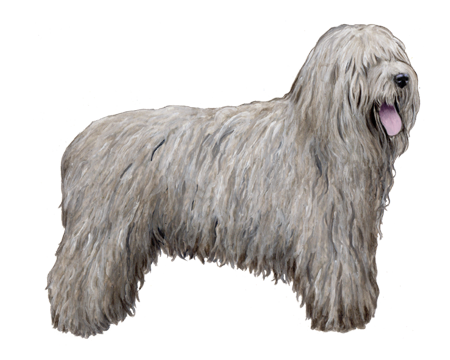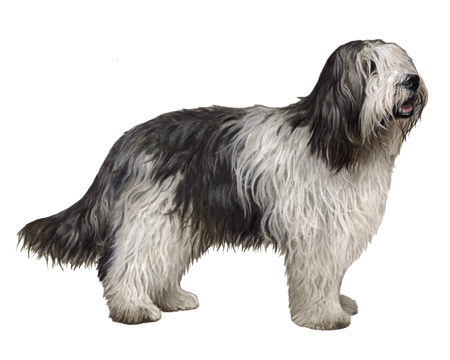
Komondor
Komondors are big, brave dogs that show outsized devotion and affection to their loved ones. These one-time flock protectors make excellent guard dogs that will do their best to keep their families safe.
Interested in discovering if your dog is a Komondor?
Check out Wisdom Panel's DNA tests.

Komondor Traits
General Appearance
Komondorok are large, muscular dogs known for being agile, light on their feet, and moving with long strides.
Coat and Colouring
The Komondor is known for its trademark coat. It is a double-coated breed with a dense, soft, woolly undercoat and an overcoat made up of strong, tassel-like cords that form naturally from coarse, wavy, or curly hair. The cords, which feel like felt, grow longer with age.
Puppies have soft, curly coats; as the dogs grow, their coats turn into short cords with fluffy balls on the ends. The breed standard does not penalize younger dogs for not having fully-formed cords but dogs whose cords fail to form by the time they are two years old are disqualified. Komondorok are white. Puppies might have cream or buff shading that fades with age.
Distinctive Physical Traits
Komondorok are large dogs with significant bone and substance. They have level, strong backs; deep, powerful chests; muscular fore- and hindquarters; large feet with close, well-arched toes; and tails that are long enough to reach the hocks when hanging. Komondorok also have large heads, almond-shaped eyes, and triangular ears that are rounded at the tips.
Komondor Temperament
Although Komondorok are large, imposing dogs that were bred to take on predators, they are loving lapdogs with their families. Komondorok are still working dogs at heart and thrive when provided opportunities to look out for others, which is the reason these are great guard dogs.
These courageous protectors can be wary of strangers so socialization is essential. Komondorok may also perceive a group of unfamiliar dogs as a threat and go on the offensive, making them ill-suited to playing off leash at the dog park or doggie daycare.
Due to their quiet natures and moderate exercise needs, Komondorok make surprisingly good apartment dogs.


Komondor History
The Komondor is the largest of the Hungarian breeds. The dogs are believed to be descended from the Owtcharka, an Asian shepherd dog that was brought to Hungary around the tenth century. Unlike other breeds that farmers used to help with livestock, Komondorok (the plural of Komondor) were not bred to herd sheep, just protect them.
While working in harsh conditions, these dogs made excellent guardians, protecting sheep from predators such as wolves, coyotes, and feral dogs. The dense white cords of their coats helped Komondorok blend in with their flocks and provide protection against the elements and predators.
Komondor Care
Nutrition
Despite their size, Komondorok do not eat big meals. These dogs will do best when fed a high quality dog food that is appropriate for their life stage (puppy, adult, senior).
Grooming
Komondor cords might grow naturally but achieving a beautiful coat requires care. Before Komondorok reach one year old, their coats start to clump; separating the clumps into quarter-sized sections ensures that the cords will grow out beautifully.
Mature cords cannot be brushed but occasional baths help keep them clean. Komondorok must have their coats dried completely after a bath. Use a fan or lots of towels and squeeze-drying to remove all of the moisture and prevent the cords from becoming smelly.
Komondorok also need regular ear cleanings, nail trims, and a dental care routine that includes at-home teeth brushing and professional cleanings.
Exercise
Komondorok have moderate exercise needs. Daily walks or games of fetch in a fenced yard will help them burn off their energy. Do not expect Komondorok to go outside to play on their own; these are very social dogs that are devoted to their owners. Their protective instincts make them want to keep their families close; these dogs do not want to be left alone for long periods.
Training
The Komondor excels at working solo, making decisions for the wellbeing of its flock without direction from a master. Thus, the breed retains that stubborn, independent streak. Consistent training can help Komondorok master basic commands and learn new tricks. These dogs respond best to positive reinforcement and rewards; training that is too heavy-handed could cause Komondorok to shut down.
Socialization is important, too. Komondorok have strong protective instincts and need lots of positive interactions with strangers in order to learn to let their guards down.

Komondor Genetic Health Conditions
-
Intestinal Cobalamin Malabsorption (Discovered in the Komondor)
Intestinal Cobalamin Malabsorption (ICM) or Imerslund-Gräsbeck Syndrome is a disorder where the body is unable to absorb cobalamin (vitamin B12) in the small intestine. This results in weakness and failure to thrive, vomiting, diarrhea, anemia, and decreased numbers of white blood cells (immune system cells).
Knowing if your Komondor is a carrier or at-risk for these conditions can help you and your veterinarian plan for your pup's lifelong care. With Wisdom Panel™ Premium, you can get results for over 200 genetic health tests.
Breed Group
Herding
The herding group is a diverse category. These highly intelligent breeds were developed to guard and control the movement of livestock.
Resources
https://komondorclubofamerica.org/about-the-komondor/
http://images.akc.org/pdf/breeds/standards/Komondor.pdf
https://www.akc.org/dog-breeds/komondor/
Reviewed 26 July 2020 by Cindy Elston, DVM, MPH

































































